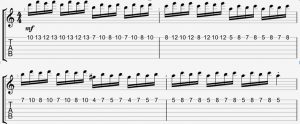How To Increase Guitar Playing Speed Using Sequences
by Richard Freeman
How often do you watch your favorite guitar players and just sit there and think, “Man, how does (insert famous guitar player name) know how to navigate the guitar neck so flawlessly?”. It can seem overwhelming at times to see an incredibly fluent guitar player rip through sections of the guitar neck in a seemingly effortless way. Don’t fret though, there is a way to get started navigating yourself through the fretboard. What we are going to look at today is a few phrasing sequences that sound awesome, are fun to play, and are going to increase your speed, 2 hand synchronization and fretboard knowledge!
But first before we begin, let’s cover a few important concepts about learning a sequence. Understanding these questions/concepts is going to give you the knowledge to allow you to implement sequencing into your actual playing, songwriting and improvisation.
- What is a sequence? – In music, there are many different definitions for sequences depending on how they are written. In this article, our examples will be of Tonal Sequences & Rhythmic Sequences.
- Tonal Sequence – A sequence where the subsequent segments are diatonic (in the same key) transpositions of the first section of the sequence.
- Rhythmic Sequence – A sequence where the rhythm of the subsequent segments are exactly the same as the first section of the sequence.
- Why is learning this (or any) sequence important and going to help me? – Sequencing is a way to play any phrase that contains any number of notes in several different areas of the guitar fretboard, (sometimes even while using the same finger pattern). By learning how to create your own sequences, you will be able to replicate phrases all over the fretboard in many different scales, octaves and positions. Having sequences that you are able to quickly draw from your playing arsenal is going to help you not need to think so much about what you want to play. In other words, once you begin to hear the way different sequences sound, you will be able to recall these phrases quickly and will already know what they will sound like before you play them. Sequencing is also going to allow you to drastically increase your speed with precision and timing accuracy.
- Where & When can I use sequencing? – Sequencing is usually used during soloing and improvisation. It can also be used when songwriting or recording. A better way to put it is: You can use sequences anywhere you feel comfortable and think it sounds good.
- How Should I Practice Sequences? – Start out by practicing with different tempos, rhythms and sub-divisions. Playing a sequence in 8th notes sounds completely different than playing a sequence in 8th note triplets, 16th notes, quintuplets or sextuplets. When practicing your sequences, you should try to master and vary each of these areas.
- Can / Should I Alter Sequences? – You definitely can! Actually, in order to achieve some of the sub-divisions listed above, it may be necessary to alter your sequence slightly to accommodate a quintuplet rhythmic feel.
- Always Use A Metronome – In order to consistently increase speed with your sequences, you need to apply/track them with a metronome. Move up in 3-5BPM increments until you reach your max speed. Then continue working towards topping your max speed each week until you are satisfied with your top speed!
Sequence 1
This first sequence is simply based off of a major scale, in first position, while using an interval sequence of 3rds throughout the entire scale.

Sequence 2
This second sequence is based off of the harmonic minor scale, and descends in 8 note groupings while using an interval structure of 3rd’s as well.

About the author: Richard Freeman lives in Miami, FL and is a professional guitar teacher with training and expertise in Rock & Blues genres. With several guitar playing articles published in many countries, Richard’s hope is to educate guitar players everywhere. If you are looking for guitar lessons in Miami, FL, contact Richard today!
